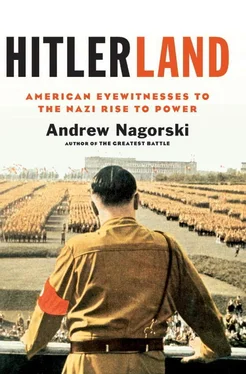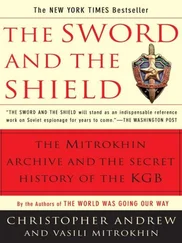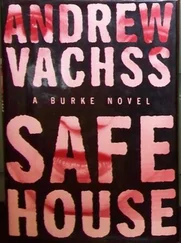“That ugly old city, it seemed to me, had been the seat of too much evil to deserve either remorse or sorrow when it was smashed to pieces like the pianos at Wertheims.”
For all the shattered glass, however, it still remained possible for American visitors to come to Germany and miss much of what was happening around them. Phillips Talbot, who had studied along with Thuermer at the University of Illinois and would become a well-known Asian specialist and diplomat, visited Berlin soon after Kristallnacht. He had been a cub reporter for the Chicago Daily News and was invited by Wallace Deuel, its Berlin correspondent, to stay in his apartment. Talbot met up with Thuermer, who pointed out the evidence of what had just transpired. “Do you see that?” he asked, pointing to a second-story shattered window on the Kurfürstendamm. “I watched them break that one on the big night.”
Speaking about his brief experience in Germany long afterward, Talbot admitted that if it hadn’t been for what he learned from Thuermer and Deuel, he could have easily missed much of what was happening. And he still came away with, at the very least, mixed impressions. “Measured by efficiency, it [Germany] didn’t look bad,” he recalled. In a letter dated December 27, 1938, written shortly after his German visit, he wrote: “But it would be unfair to mention the evidences of the anti-Jewish campaign without some of the other things I saw.” He listed “the physical results of Nazism… the super-roads, the busy slum clearance and new housing, the bridges and public buildings,” which “all give the country a flavor of newness.” He did add, though, that “some of the stories of methods told by people who should have no ax to grind are chilling.”
For many of those Americans who had been monitoring these chilling developments, it was no longer possible to pretend that the new Germany represented anything like a normal mixture of good and bad, and should still be treated like a normal country. In a letter to Assistant Secretary of State Francis B. Sayre on November 14, Wilson finally admitted that it was futile to keep hoping that reasonable officials within the German government would succeed in producing “some moderation of the National Socialist racial policy, at least to the extent of permitting orderly emigration of Jews with a fairly substantial portion of their property.” He concluded, “The events of the last few days apparently dispel such hopes.”
Facing growing outrage against the Nazi regime, the Roosevelt Administration recalled Wilson to Washington for consultations the next day. He would formally remain ambassador to Germany until August 31, 1939, the eve of Germany’s invasion of Poland, but he never returned to Berlin during that period. After Wilson’s departure, the embassy was run by lower-level diplomats. Although he had been disappointed by Wilson’s performance, Jacob Beam noted that the decision not to replace him “dealt our Embassy a sad blow.” Without an ambassador to maintain ties at the senior level with Nazi officials, he wrote, “a bizarre state of non-communication was allowed to develop to our overall disadvantage.”
Many of the embassy staffers were focused increasingly on determining Germany’s war capabilities and intentions, and no one was more experienced in that department than Truman Smith. The veteran military attaché was constantly on the lookout for new opportunities to gather more intelligence. He had engineered Lindbergh’s visits to Germany that had provided an inside look at many of the Luftwaffe’s factories and airfields. At the same time, he took advantage of the arrival of two other U.S. Army officers who were provided with a different kind of inside look at another aspect of the German military—in this case, its officer training program and its engineering capabilities.
Remarkably and inconspicuously, the United States and Germany had agreed in 1935 on an exchange of students in its officer training schools—the Command and General Staff School at Fort Leavenworth, Kansas, and the German War College, or Kriegsakademie, in Berlin. The program was to start the following year, but the Germans failed to avail themselves of this opportunity, probably because of their belief that their officers could get better training at home. “It was suggested tactfully that the Germans did not think very highly of the U.S. course of instruction at Leavenworth,” wrote Albert C. Wedemeyer, the American officer who enrolled in the German War College, staying for the full two-year course from 1936 to 1938.
At the time a young captain from Nebraska, the “tall and handsome” Wedemeyer, as Kay Smith noted, immediately hit it off with her husband. Kätchen Smith, their daughter, recalled that Wedemeyer and Paul Thompson, another young officer from the Midwest who was also studying in Germany, would often come over for Sunday brunch. Thompson was an army engineer and he was enrolled at the Technical University in Berlin.
According to Kay, Thompson was “out-going, hard-working, modest, handsome with rosy cheeks, brown eyes and dark hair and a winning personality. He was very young and naïve socially but not professionally.” Or, as Kätchen recalls, “Paul was wet behind the ears—truly innocent.” Her parents worried about his relationship with a German woman named Friedl, fearing that she could be taking advantage of him. When he announced to the Smiths that he was going to marry her right before he was due to sail back home, Truman told Kay: “I hope she is not just getting a trip to the United States as so many have.” But the Smiths attended their civil wedding and saw them off.
Since Thompson had already acquired considerable experience dealing with flood control on the Mississippi River, he didn’t feel he was learning much in his courses in Berlin. Truman managed to get him assigned to a German Army engineer battalion instead, where he closely observed the Germans’ methods and equipment. His subsequent report, according to Kay, “brought Thompson to the attention of his superiors in his branch and from then on… his rise was spectacular.” He later trained U.S. Army engineers for the D-Day invasion and landed on Omaha Beach, where he was shot through the jaw. He survived and was decorated for bravery. After the war, he retired from the Army and started a second career as a senior executive at Reader’s Digest.
But of the two young American officers who studied in Germany in this period, it was Wedemeyer—who would later rise much higher in the military hierarchy, succeeding General Joseph Stillwell as commander of U.S. forces in China—who gathered the most valuable information. The young captain took his duties as an exchange student at the German War College extremely seriously, keeping a meticulous record of everything he learned and observed over two years, which he summarized in a 147-page report for his military superiors. It offered the military brass valuable insights into the training provided to many of the best German officers who were destined to fight in World War II.
In his report, Wedemeyer left no doubt how much he admired the German training program and its mix of in-depth military history and practical exercises of “Troop Leading,” allowing the officers to simulate battlefield conditions they were likely to face so that they could apply new tactics. “The situations presented at the Kriegsakademie involve War of Movement, special emphasis being placed upon speed, in anticipation of the employment of mechanized and motorized forces,” he wrote. Officers were taught to make quick decisions, recognizing “that a fair decision given in time for aggressive execution is much better than one wholly right but too late.”
All of which indicated that the Germans were preparing for new forms of combat. “They visualize rapidly changing situations in modern warfare and gearing their command and staff operations accordingly,” he wrote. In essence, he was previewing the blitzkrieg tactics that Hitler would first unleash on Poland the following year.
Читать дальше











